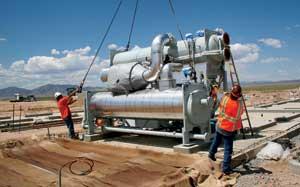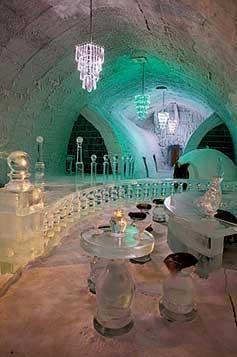by Teresa Hansen, editor in chief
The International Geothermal Association (IGA) reports that electricity has been generated commercially by geothermal steam since 1913, and its use to generate electricity has increased substantially around the world, especially in the past few years. IGA reports that from 1990 to 2007, the total installed generating capacity worldwide increased from 5,832 MWe to nearly 9,728 MWe.
The United States continues to be the world leader in generating electricity from geothermal energy. According to the Energy Information Administration (EIA), geothermal energy in 2005 generated approximately 16,010 Gigawatt hours (GWh) of electricity in the United States (approximately 0.36 percent of U.S. annual electricity generation). Currently, seven states use geothermal technology to generate electricity with capacity rated at about 2,958 MW. The Geothermal Energy Association's (GEA's) data shows continued growth in the number of new geothermal power projects being developed in the United States, with a 20 percent increase since January.
Geothermal technology
Geothermal electricity generation mainly takes place in conventional steam turbines and binary plants, depending on the characteristics of the geothermal resource. Conventional steam turbines require fluids at temperatures of at least 300 F, according to the IGA. Recent advances in binary geothermal technology, however, have made it possible to economically produce electricity from lower-temperature geothermal resources?200 F to 300 F.
Recently, the U.S. Department of Energy (DOE) worked with several entities on a binary geothermal power system that uses the Rankine cycle. A demonstration plant using the technology began operation in 2006 at the Chena Hot Springs Resort, 60 miles from Fairbanks, Alaska. The single prototype module produces 200 kW of net power from 165 F water, the lowest-temperature geothermal resource ever used for commercial power generation in the world.
The Chena project uses PureCycle geothermal technology developed by UTC Power, a United Technologies Corp. company. The three-year project was supported by and received funding from the Chena Hot Springs Resort, DOE, Alaska Energy Authority, Alaska Industrial Development and Export Authority and the Denali Commission.
Although output from the installation is considered small for a baseload power plant, the Chena plant represents a huge leap forward for moderate geothermal development and greatly expands the number of geothermal resources that can be economically developed. Prior to the operation of the power plant at Chena, the lowest-temperature geothermal resource ever developed for commercial power generation was 208 F.
The PureCycle technology used to generate power from moderate temperature geothermal resources (200 F to 300 F) has been available since the late 1970s, when binary organic Rankine cycle (ORC) power generation was demonstrated for use as a bottoming cycle on steam power plants. Because moderate-temperature geothermal power plants that used this technology were built to order using tailor made components, long lead times were required and the cost of the equipment was around $3,000 per kWhr installed capacity.
UTC's Research Center, together with its sister divisions, Carrier Corp. and UTC Power, are reverse-engineering, mass-produced Carrier chiller components. This manufacturing process dramatically reduces power plant construction costs by taking advantage of the large-scale mass production already in place for the air conditioning industry while simultaneously allowing for modular construction. The power module produced by UTC is designed to resemble a chiller and, like a chiller, it is simple to install. The first power module arrived at Chena on July 8, 2006, and produced power within one month's time. The site work consisted of providing hot water to the evaporator and cold water to the condenser.
Prototype plant performance
The Chena prototype plant includes a single 480 V three-phase electrical power connection. It runs without an operator; the integrated control system brings the unit online and monitors for any potential problems.
The plant provides power for the resort's on-site electrical needs. All 44 buildings at the resort?including a greenhouse, hotel, cabins and ice museum?are linked by a geothermal district heating system. The geothermal plant is a source of emission-free renewable energy, and in Alaska its success is particularly significant for rural village applications where more than 300 communities (including Chena Hot Springs prior to July 2006) burn diesel fuel in gensets at costs ranging from 30 cents/kWhr to 86 cents/ kWhr. In late 2006, the initial prototype power plant installed at Chena reduced the local cost of power from 30 cents/kWhr to 6 cents/kWhr.
In late 2006, a second prototype unit was installed and began operating at the Chena site. The two prototype units have operated at more than 95 percent availability since they were placed in service.
According to John Fox, Pure Cycle general manager at UTC Power, the units have operated with water temperatures as low as 157 F.
"This was not by design, but because of some issues with the well," he said.
Fox said the units, which operate on R134 refrigerant, have accumulated more than 12,000 operating hours and have required only minor repairs.
In addition to the two prototype units, the Chena Hot Sprints Resort recently added its third unit. This newer generation 280 kW (gross) unit is much closer in design to the units now in production and will be used to map performance on the low resource temperature in an effort to offer commercial units at operating temperatures lower than 200 F. According to Fox, the unit is not yet operating but has been commissioned.
The first two production units of the PureCycle geothermal power system were installed at the Burgett Greenhouse in Animas, N.M., this past July and August. The Burgett Greenhouse covers some 32 acres of rose gardens. Owner Dale Burgett was already using 227 F water from on-site wells to warm his greenhouse. UTC Power installed the two units in front of the greenhouse. The units produce enough power to meet the greenhouse's electricity needs (fans, pumps, etc.) and the water that exits the geothermal units is still warm enough to heat the greenhouse. In addition, once the water passes through the greenhouse, Burgett passes it on to his neighbor's fish-farming operation.
Other production units have been installed and more are on order. Raser Technologies Inc. of Provo, Utah, ordered 200 PureCycle units for eight projects it is developing throughout the Western United States. Recently, The renewable energy company discovered the largest geothermal resource in the nation in the past 25 years in southern Utah.
Its first project, which was just completed, is near Beaver, Utah, and is the first installation to use modular technology. The installation consists of 50 PureCycle production units networked together to form a 10 MW power plant. The construction time for the installation took about six months. The project was dedicated Nov. 6 during a ribbon-cutting ceremony, marking a milestone in low-temperature geothermal technology for electric power generation. The entire site is estimated to contain as much as 238 MW of geothermal resources if fully developed.
In a presentation at the recent Geothermal Energy 2008: Expo and Conference ,Karl Gawell, GEA's executive director, called this first phase of Rasor Technology's 200-unit installation the "beginning of a renaissance in the geothermal industry."
The power from the 50-unit installation has already been sold to Anaheim, Calif.
An additional PureCycle production unit is being installed at a Guatemalan textile plant where waste heat in the form of hot water will be used to operate the units. The company is working on similar projects with several other companies in Central America.
"In power generation, it is typical that a lot of waste heat that is not being utilized," Fox said. "Diesel engines are currently used in many remote areas, mining operations, fisheries and on islands to generate electricity."
The PureCycle technology can tap the waste heat resources to displace much of the expensive, less environmentally friendly diesel power.
UTC power is currently producing three PureCycle units a week and hopes to reach six per week by year's end, based on demand.














